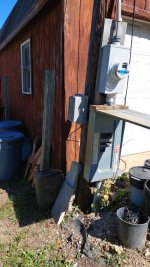This says you need a 50A breaker. It will draw more than 30A at times and a 30A breaker will trip. This also means you need the correct 6AWG wire.Thank you for the info. 261 zip codes aren't too far.
I am most interested in making oval and rectangle pots as large as this kiln will handle.
I have a new shed being built atm, and will be running water and electricity under ground to it as well as buying and installing a wood stove. So I'll be pretty tied up the rest of the year.
I will keep you in mind and holler at you to coordinate a schedule. Thank you.
BTW, about how many hours would a cone 6 cycle take?
I don't like thin pots, not sure if thickness of clay matters here.
Hi Nao
Good thought on the circuit size and run.
Given the plug schematic above, is there any reason a 30A circuit breaker wouldn't be proper if the kiln is specd at 30A, or should I have the next size up breaker?
Don't know if this is a 208 or 240V kiln. How important is this?
For your 60A circuit I'm reading a minimum of 6AWG.
Also reading in charts that this wire I have at 90°C insulation carries up to 40A which seems perfect for the short length of run I'll have.
The shed is next to my service pole and meter. I may be able to touch the service breaker box on the pole (where I access power) and the breaker box in the shed at the same time. So voltage
You can fire in 8-10 hours of actual electricity use. The other time is candling and cooling. It's roughly $8 for a bisque firing and $12 for a cone 10 in my area.
https://kruegerpottery.com/products...t6svNFmSkT5O_LM5pmxSjKp7mENVlNz9RnTGPAXjx_0Mj


